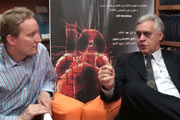ALERT!
This site is not optimized for Internet Explorer 8 (or older).
Please upgrade to a newer version of Internet Explorer or use an alternate browser such as Chrome or Firefox.
Randas J. Vilela Batista, MD

Randas Batista went to Boston in 1972 to specialize in general surgery. After spending six years there, he went to Canada, England and France to learn new cardiac surgical techniques. In 1983 he returned to his native town, Curitiba, south of Rio de Janeiro. Since then he has lived in the small town, content to work for and with the poor. Recently, he set up a foundation for cardiac patients at Curitiba and is still building a hospital there for these patients. (He has even been known to get up on a ladder to help with the building!)
In 1983, a 36-year-old Dr. Randas J. Vilela Batista performed an unconventional, procedure called ventricular remodeling, trimming an enlarged heart to normal size. He has now performed over 1000 of these operations. Although this procedure is now widely superseded in the western world by high technology alternatives such as LVADs, it is still performed in developing countries.
In this video, he describes his idea for the treatment of patients with Eisenmenger's Syndrome. Once cyanosis has developed and the shunt across the VSD has reversed, conventional thinking dictates that the condition is not amenable to surgery. Dr Batista explains what he does to reverse the situation, and improve saturations to a level where the patient is operable on their primary pathology.
CTSNet hosts this video in order to gain your views on this concept. We acknowledge that the concepts he outlines have not been published in peer-reviewed journals or comparative studies and therefore just represent Dr. Batista's views and experience of this condition. Maverick or Master—you decide!





Comments